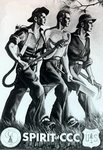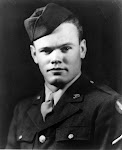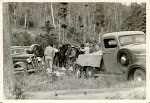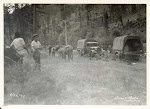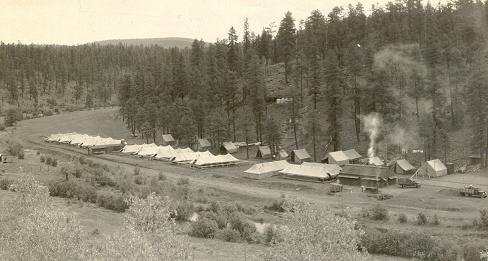 |
| CCC veterans gathered for an event in Paysonm, AZ. (L-R): James Grose, Arquimedes Fraijo, Jack Duncan, Owen Carolan, John McLeod (rear), Bill Millard Fred Garcia and Mackie Clark |
Chapter 44 of the National
Association of Civilian Conservation Corps Alumni (NACCCA) was organized in
1981 and since that time has been in continuous operation under the guidance of
ten different presidents and a host of able officers including Audrey Clark who
has served as our valued Chapter Secretary for many years, Fred Garcia, our
Chapter Treasurer who has put in more time as a Chapter officer than anyone
else, and Jack Duncan, our long-serving and most recent Chapter Vice-President.
For those not inclined to do
the math, that’s 31 years of effort, working to preserve and share the history
of the Civilian Conservation Corps. In
that time, the Chapter has placed plaques and statues from one end of Arizona
to the other; plaques in places like Grand Canyon National Park, the Arizona
state capitol in Phoenix, Colossal Cave and Chiricahua National Monument and
statues at Colossal Cave Mountain Park near Tucson and Phoenix South Mountain
Park. We created a CCC museum exhibit at
South Mountain Park and hosted a traveling exhibit which we staffed at history
events at South Mountain Park, Pueblo Grand Museum, the Arizona Historical
Society Museum in Phoenix, in Payson, Arizona and elsewhere.
 |
| Gerald Johnson, CCC and USMC Veteran and Arizona CCC statue donor |
Certainly the crowning
achievements in the Chapter’s resume must be the purchase and placement of two
CCC worker statues in Arizona. The initial
task of raising funds for an Arizona CCC statue was undertaken as something of
a shoestring effort but labored along for more than a year. Just when it appeared that the fundraising
effort would stumble into failure, CCC alumnus Gerald Johnson of Bisbee,
Arizona stepped forward to donate sufficient funds to acquire Arizona’s first
CCC statue, which was placed at the Colossal Cave visitor center.
 |
| Jack Duncan, CCC Veteran and and Arizona CCC statue donor |
We might have stood content
to have helped get Arizona a single CCC worker statue but in typical we can do it fashion, another CCC
veteran stepped forward to offer his help.
Jack Duncan, who worked in the CCC in Colorado and who has served so
well as Chapter 44 Vice President put up the money to buy a second CCC worker
statue outright. Arizona’s second CCC
worker statue was erected at Phoenix South Mountain Park.
In hindsight, it seems clear
that Arizona would not have even one CCC worker statue were it not for the
generosity of former enrollees Gerald Johnson and Jack Duncan, who provided
sufficient funds to make the purchase. Additional
funds raised by Chapter 44 helped with incidentals associated with placement of
the statues and remaining monies have been used to purchase the Happy Days
newspapers and Arizona camp newspapers on microfiche for the Arizona State Archives. The singular generosity of Gerald and Jack
made it possible for the Chapter to do so much more in these last few years
that would otherwise have been possible.
 |
| CCC Plaque at Chiricahua NM in Southeastern Arizona |
Among the Chapter’s other
significant accomplishments: We
commissioned a portable exhibit case, which we then filled with CCC artifacts
and donated to the National Park Service in Flagstaff. Chapter 44 hosted the 2004 NACCCA reunion and
sponsored a writing competition to mark the 75th anniversary of the
CCC in 2008. We donated funds to help
restore a scale model of the battleship USS Arizona. In 2010 we donated the entire available
editions of Happy Days newspaper on
microfilm to the Arizona State Archives and we have recently acquired all the
available editions of Arizona CCC camp newspapers to donate to the State
Archives in honor of the CCC’s 80th anniversary early next
year. Along the way we also helped and
inspired historians and writers including Robert Moore, Jane Jackson and Robert
Audretsch, who sought us out in their efforts to document the history of the
CCC.

